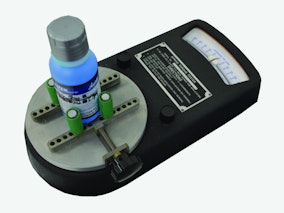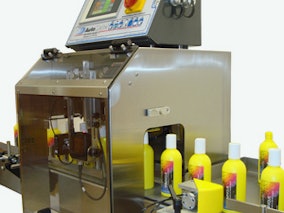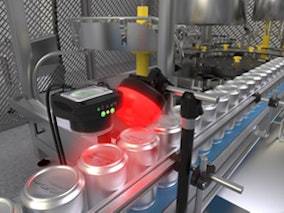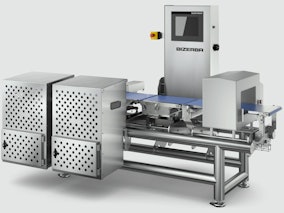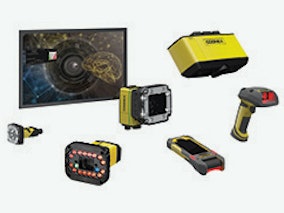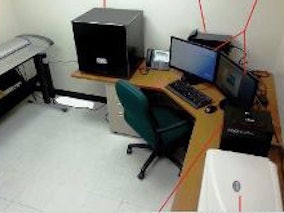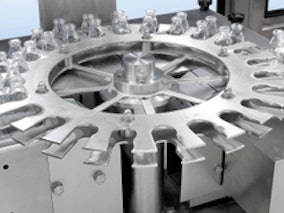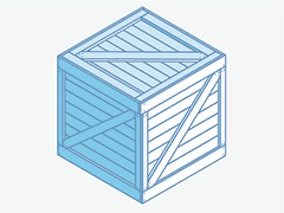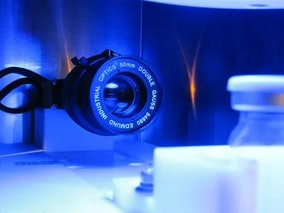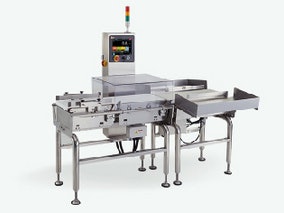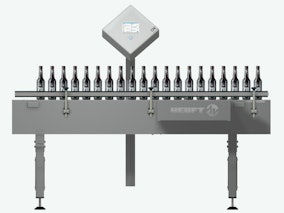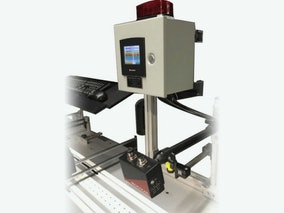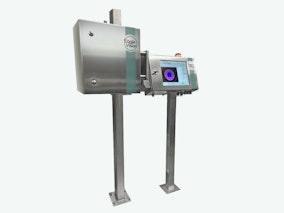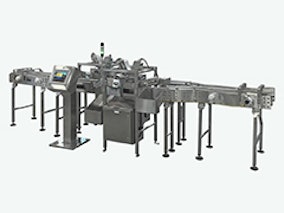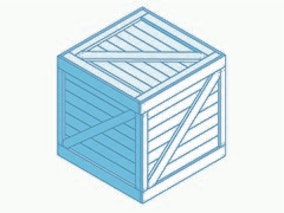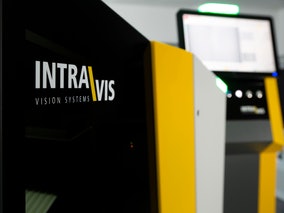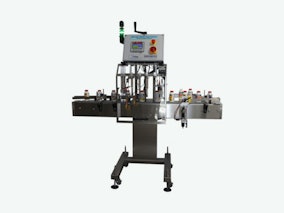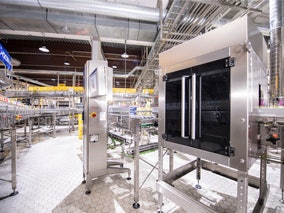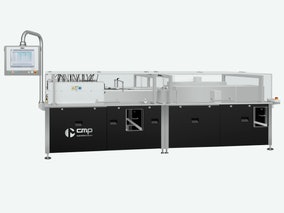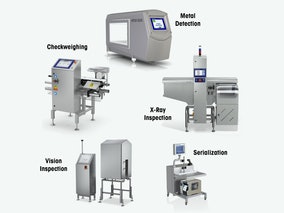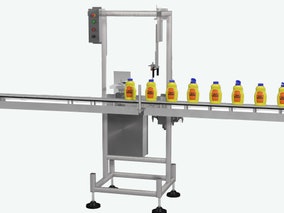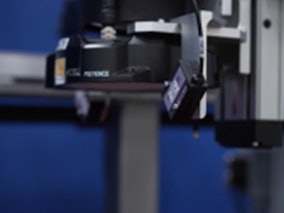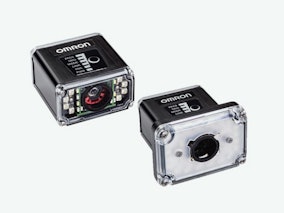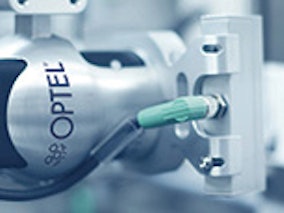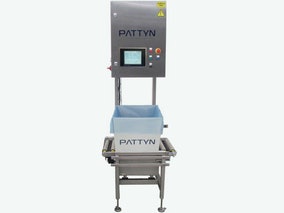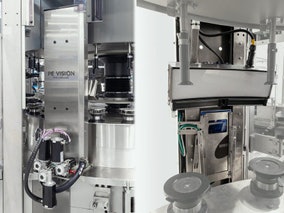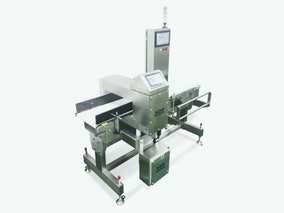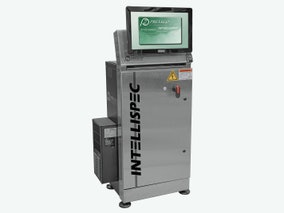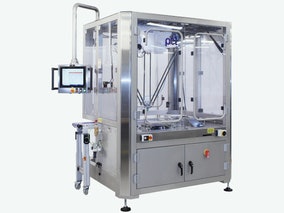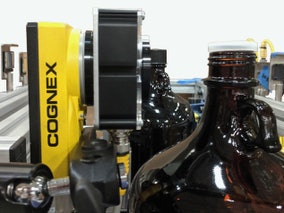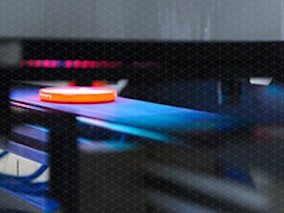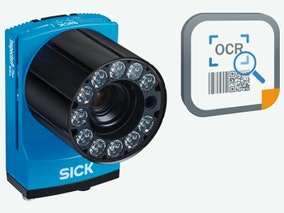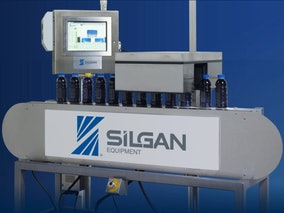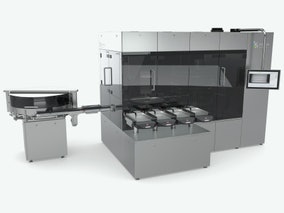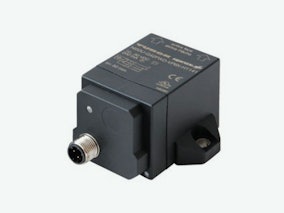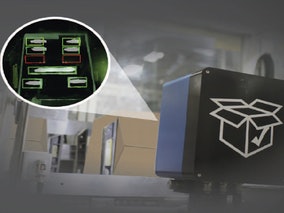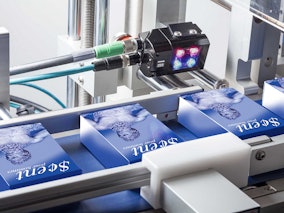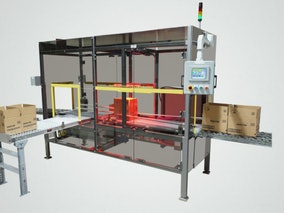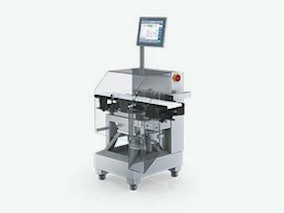Vision Inspection Systems
(43 companies)Also known as machine vision (MV), vision inspection systems use cameras and other imaging technologies to detect defects. Looking for tips and best practices on inspection and testing equipment? Explore related articles now.
 See us at S-2166
See us at S-2166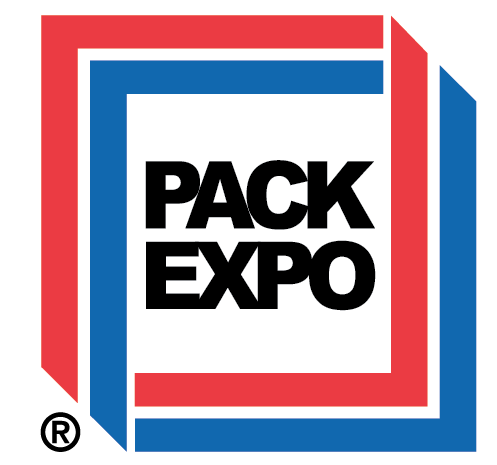
Accutek Packaging Equipment Co.
The Accutek Inspection-Rejection Station system is designed to perform comprehensive inspections on various aspects of product packaging. It utilizes advanced technology to detect and reject containers that do not meet specific criteria. The system checks the orientation of containers to ensure they are positioned correctly, identifying and rejecting containers that are upside down or not aligned properly. The system also verifies the fill levels in containers, ensuring they meet the required standards, detecting overfilled or underfilled containers and reject them accordingly. Other applications include metal or contaminants in the product, whereby Accutek's system employs sensors or imaging technology to identify the presence of metallic objects, contaminants or foreign substances in the product. The system also examines the placement and alignment of caps on containers for skewed caps, missing caps, missing foil liners, crooked or missing labels.
 See us at S-3754
See us at S-3754
Antares Vision Group
Antares Vision offers a wide range of innovative visual inspection systems to detect defects on high speed, automatic lines for pharmaceuticals, medical device, cosmetics, beverage and food packaging lines. Systems detect package, product and label integrity, as well as label print consistency, label position consistency, and seal application. Systems provide the complete visual inspection of production line sample checks, cosmetic imperfections, print quality and product consistency to ensure the reliability of production processes for complete consumer safety.
 See us at N-5720
See us at N-5720
Auto-Mate Technologies LLC
AutoMate supplies the industry with two bottle and packaging inspection systems: the AM-QC and the AM-DA Diagnostic Center. Model AM-QC provides product quality assurance, accuracy and integrity in one centralized machine, performing inspection tasks such as torque monitoring; detection for missing caps, missing or skewed labels, missing neck bands and foil seals; bar code verification; color correctness; conveyor speed monitoring, crooked/ loose cap detection; date/lot verification; verification of cotton placement and more. The AM-DA provides inspection and quality assurance through non-contact, non-destructive testing, with reject systems that gently remove products.
 See us at N-5643
See us at N-5643
Banner Engineering Corp.
Sensors and smart cameras from Banner Engineering are able to quickly inspect packages for defects. Sensor equipment includes photoelectric, registration mark, color and luminescence sensors, radar sensors, ultrasonic, as well as temperature and vibration sensors. Smart cameras include the VE high-resolution vision camera and barcode reader. All of Banner’s sensors and smart cameras set themselves apart by being easy to set up, teach, and deploy. Banner Engineering also provides lighting, vision lenses, and software for inspection applications. Contact an application engineer today for assistance with an inspection application.
 See us at S-2066
See us at S-2066
Bizerba USA, Inc.
Bizerba USA is an original equipment manufacturer of a broad range of packaging inspection equipment, including checkweighers, metal detectors, X-ray systems and vision inspection systems. Featured inspection systems include the CWFmaxx line of checkweighers, mainly used in food processing companies who have to meticulously clean their systems. The stainless steel housing is suitable for use in hygienic environments. All components are easy to access, so that they can be thoroughly cleaned. The shape is designed to prevent the accumulation of dirt.
 See us at N-6004
See us at N-6004
Cognex Corporation
Cognex machine vision systems help companies improve product quality, eliminate production errors, lower manufacturing costs, and exceed consumer expectations for high quality products at an affordable price. Typical applications for machine vision include detecting defects, monitoring production lines, guiding assembly robots, and tracking, sorting and identifying parts. Product line includes Cognex In-Sight® 2D machine vision systems, 3D machine vision tools. vision software, Cognex Deep Learning technology and barcode readers.

Complete Inspection Systems
AutoProof Pro™ is Complete Inspections Systems’ software application designed to improve the accuracy and reliability of the print inspection process. Working with high-resolu]tion cameras and scanners, software acquires and converts printed copy from cartons, inserts and most any printed materials to digital format. Software compares all the copy, text and images, against a master file. Any differences, such as added, deleted, or modified copy are displayed to the operator for review and reporting. The solution is 21 CFR Part 11 compliant; includes reporting, audit trails, digital signatures, user controls and application security. AutoProof Pro™.
 See us at S-3092
See us at S-3092
Cozzoli Machine Company
Cozzoli Machine Company is a supplier of checkweighing equipment used for containers in pharmaceutical applications, inspection equipment used in cleanrooms and more. Bottle checkweigher, which can be supplied for new or existing filling lines, uses magnetic force restoration type weighing technology for high-speed, high-precision handling of up to 200 containers per minute. Inspection machines are compact, standalone units that are ideal for use in areas with space limitations, designed with class 100 clean rooms in mind. Inspection systems handle speeds of more than 600 containers per minute.
 See us at LL-9011
See us at LL-9011
Dabrico, Inc.
The DI-100 LT/XL Inspection System is designed to perform visual inspections of vials, ampoules, syringes, and cartridges, minimizing product handling. It handles a wide range of container types and sizes, with a maximum operating speed of 150 pieces per minute. Using one DI-100 LT/XL machine, one operator can achieve the same productivity as 4-5 operators in a typical manual inspection process. For ampoules, it can inspect fill level, ampoule tip, cracks, and scratches on the ampoule body. On cartridges, it inspects cake surface (for freeze-dried products), fill level, aluminum cap crimping and dents, stopper presence, and more. It also checks for fill level, cake surface, stopper presence, cracks, and scratches on vials, as well as other anomalies.
 See us at W-18041
See us at W-18041
FP Developments, Inc.
FP Developments offers engineering, design, manufacturing, and service, specialized in automation for inspection systems for the pharmaceutical industries. FP will engineer automated and semi-automated inspection machines that handle integrated weight verification, conveyor paced inspection, vial/ampoule and syringe inspection and more. FP Developments inspection systems are applicable for particulate, cosmetic, stopper, cap, and defective container inspection on a line.

Grupo Empac SA de CV
Grupo Empac distributes a wide range of metal detectors and checkweigers from Tecni Pac, including TECNI PAC® model TSR 600300, designed to detect the presence of ferrous, non-ferrous and stainless steel metallic contaminants in packaged products.
 See us at S-2276
See us at S-2276
HEUFT USA Inc
Heuft manufactures a full line of inspection equipment for products as well as for full or empty containers used in the food, beverage, and pharmaceutical industries. Highlighted equipment at the Heuft website includes the HEUFT ONE, an entry-level detection system for checking full beverage containers in a confined space. The system detects and evaluates bottles for precise fill level, closures, labels, and other criteria. Heuft inspection systems for empty food containers include the HEUFT canLine II, which detects faulty cans before they are filled and rejects them before they can affect the productivity of complete food lines and the safety of the end product. HEUFT eXaminer II XB for pharma applications features pulsed X-ray technology that can detect minute foreign particles, bent hypodermic needles, incomplete or incorrectly packaged tablets, as well as quality defects in containers, syringes and blister packs.
 See us at S-4056
See us at S-4056
HSAUSA
HSAUSA, a PMMI member, supplies barcode and vision inspection systems designed to easily integrate with any serialization packaging line. Machines include the BSC-350 barcode scanner controller which controls up to two bar code scanners/verifiers. Provides 100% inspection of 1D or 2D Barcodes, dependent on type of scanner or imager connected. Teach the controller with a handheld scanner, and the scanned codes will be confirmed against the taught code. If any “no read” conditions occur, the system can be setup to track and reject the printed or labeled case.
 See us at S-4153
See us at S-4153
INDUSTRIAL PHYSICS
Industrial Physics provides test and inspection solutions from the biggest global brands in packaging inspection, including vision systems and can integrity testers. Featured brands and solutions include the Metal Ends Inspection system from Eagle Vision Systems, which inspects damages, roundness and compound on metal can ends. Other suppliers presented by Industrial Physics include Quality By Vision, who make can-end inspection and aerosol vision inspection systems. Also highlighted on the Industrial Physics website is offline can seam inspection and measurement systems from CMC-Kuhnke.
 See us at S-1634
See us at S-1634
Integrated Packaging Machinery, LLC
IPM's vision inspection systems for packaging inspection use barcode readers including side view cameras, overhead cameras, remote control panel, and an automatic reject system. The position and number of cameras implemented is designed for system redundancy, meaning that each barcode gets read at least twice as it travels through the inspection zone, minimizing false-positive rejections. If a problem is detected, such as a wrong barcode or a misread (no read), the system automatically pushes the questionable product into a manual inspection bin.
 See us at W-16059
See us at W-16059
Integrated Packaging Systems
IPS slat counters can easily be integrated with Optel Vision Systems – CountSafe™ inspection system for greater assurance that the correct product and correct count are placed in each bottle for tablet and capsule inspection applications. CountSafe inspection system ensures that bottles are filled with 100% correct products; system inspects tablets, capsules, gel caps, dual colored capsules and dual colored tablets. Increased accuracy helps to avoid costly recalls and promotes an excellent ROI with less product rework and increased productivity.
 See us at LU-7807
See us at LU-7807
INTRAVIS Inc.
INTRAVIS makes vision systems for the inspection of plastic bottles and containers, caps, preforms, decorated/labeled packages, and barrier presence. Products include the PREMON, a preform monitoring system and the LayerWatcher, designed to simplify and accelerate the inspection of barrier layers in PET preforms. Other systems include INTRAVIS’ CapWatcher series for closure inspection and the SleeveWatcher, exclusively designed for inspecting sleeve labels.
 See us at W-15085
See us at W-15085
Jekson USA Inc
Jekson Vision manufactures an extensive line of packaging inspection machines for pharmaceutical and biopharmaceuticals, food and beverage, and other industries. Vision inspection systems from Jekson Vision include the Bottle 360 for pharmaceutical and healthcare packaging. Equipped with seven cameras, the Bottle 360 offers comprehensive helper code association and inspection. Bottle 360 boasts a modern cGMP design, meeting the highest industry standards for industry applications. Jekson also supplies BiSmart inspection machines, employing the latest in AI, ML, and deep learning technology. BiSmart is engineered to eliminate manual errors, promote increased efficiency, and ensure accuracy in meeting the stringent requirements of the packaging line. Other systems include pinhole detection systems and blister inspection systems.
 See us at N-5721
See us at N-5721
Kaps-All Packaging Systems Inc
Kaps-All distributes the AM-DA Quality Control Center from AutoMate Technologies. This diagnostic inspection center allows for non-contact/non-destructive testing and rejection of containers for multiple specifications in one center. Standard features include bottle counter and rate meter module, conveyor speed monitor with encoder and alarm module, and missing cap detector module.
 See us at W-15021
See us at W-15021
Körber Pharma, North America
Körber Pharma supplies automatic inspection engineered for the medical and pharmaceutical applications. Whether the product is liquid, highly viscous or freeze-dried, Körber Pharma has packaging inspection equipment for syringes, vials, ampoules, cartridges, and more. Designed for the high demands that pharmaceutical and biotech products and their special containers place on transport systems, Körber equipment can inspect all areas of the package or container, including tips and caps, particles or beads on the container, crimp, stopper, neck, sidewall, and bottom. In addition, Körber inspection systems perform leak detection and needle/shield detection. Systems feature Körber's Eject-X, a deep-learning feature that trains all cameras and inspection stations.
 See us at S-2766
See us at S-2766
Krones Inc.
Krones' product line of packaging inspection equipment includes vision inspection systems, fill level inspection equipment for canning and bottling lines. Krones' Checkmat inspection systems verifies if the right bottles are in the pack and there are no foreign objects in the package, among other tasks; Checkmat label inspectors also available. The Linatronic AI offers empty-container inspection technology for glass and PET containers with deep learning capabilities. ModulCheck is designed for operations with limited space or when only a single inspection is required.
 See us at W-14035
See us at W-14035
Marchesini Group USA Inc.
Marchesini Group USA offers leak testing equipment as well as glass and plastic bottle inspection systems.
 See us at S-2939
See us at S-2939
METTLER TOLEDO Product Inspection
Mettler Toledo’s broad range of product inspection systems includes checkweighers, metal detectors, x-ray inspection systems, track and trace systems, vision inspection, and more. Systems are made for all types of bulk and packaged products for environments ranging from dry to harsh wash-down and can detect solid contaminants, verify product weights, mark and verify packages, ensure accuracy and integrity of packaging and labels, confirm component content, inspect closures, and measure fill levels.
 See us at S-2530
See us at S-2530
New England Machinery
New England Machinery’s inspection rejection system (NEMIRS) inspects for skewed caps, missing caps or foil liners. It can detect down bottles, misoriented bottles, crooked or missing labels and more. Depending on the inspection requirement, the NEMIRS uses photo eyes, proximity switches, limit switches, UPC and 2D scanners or vision systems. Containers can be rejected using an air blow-off, diverter arm, or push cylinder. Rejects can be rejected to a table, collected in a bin, or transferred to an existing system.

Norwalt
Norwalt offers turnkey inspection systems utilizing 2D and 3D vision and laser inspection for pre- and post-assembly verification. Integrated vision systems can go into any assembly and serve industrial needs through deep machine learning. As part of its reject verification system, Norwalt’s vision system capabilities include: defect detection, AI assisted Inspection, 3D Inspection, fill height, product shape and more.

Omron Automation Americas
Omron Industrial Automation's comprehensive machine vision hardware line includes industrial cameras, vision systems and smart and PC-based cameras that are scalable across software platforms. Portfolio offers compact form factors for tight spaces, high-speed imaging for fast-moving production lines, and high resolutions for detailed inspection. Featured systems include the MicroHAWK F430, representing the next generation of Omron’s popular MV-40 model. Featuring the smallest IP65/67-rated, true industrial Ethernet smart camera now with expanded functionality, Omron Microscan's machine vision tool is designed for solving multiple vision inspection challenges.
 See us at W-13079
See us at W-13079
Optel Vision
Optel supplies machine vision systems for the pharmaceutical industry, designed to ensure quality and safety. Offering more than 60 features for inspection categories, Optel's equipment covers product inspection (unit dimensions, shape, color, etc.), packaging inspection (integrity, seal, inserts, cap and tamper-evident seals), as well as labeling and printing (label presence, orientation, print positioning and quality, etc.) Featured systems include OPTEL’s InspectProof, a flexible automated vision system that provides extensive inspection of labels, cartons, trays, devices and cases at rates of up to 2,000 ppm.
 See us at LU-8741
See us at LU-8741
Pattyn North America, Inc.
Pattyn North America’s quality control equipment include machine vision systems for processing applications and the CW-11 check weigher, which weighs boxes to check if the weight is situated between the set limits. Available with a reject conveyor, the check weigher uses a roll conveyor instead of a belt so that the box will be rejected in the same position. Standard check weigher handles up to 12 c/min, while a continuous check weigher handles higher speeds above 12c/min.
 See us at S-3514
See us at S-3514
P.E. Labellers
P.E. Labellers offers vision systems with cameras or smart cameras for container orientation with maximum precision even at high speeds. Qcheck solutions installed at the outfeed check for the presence and correct position of applied labels to ensure the highest quality standards. The same cameras can also be used at the infeed to check the filling level, the presence or absence of the cap or the color of the product inside a transparent bottle.
 See us at N-5767
See us at N-5767
Pepperl+Fuchs, Inc.
Pepperl+Fuchs offers vision sensors and vision systems for every requirement in industrial vision. The comprehensive portfolio ranges from universally applicable sensors to application- or customer-specific products to turnkey solutions, always with the goal of ensuring reliable image processing.
 See us at S-3582
See us at S-3582
PPi Technologies Group
PROFILE Packaging and PakSource Global offer a full range of checkweighers including metal detectors and combination metal detectors/check weighing systems as well as a full range of X-ray machines for both flexible and ridged packaging.

Pressco Technology Inc.
Pressco's INTELLISPEC platform provides high-speed inspection of various packaging components such as preforms, empty bottles, filled bottles and closures. The modular system architecture allows for multiple distributed inspection points, all controlled from a single processor. Pressco systems inspect parts at line speeds in excess of 3,000/minute.
 See us at S-2908
See us at S-2908
PTI - Packaging Technologies & Inspection, LLC
PTI offers testing equipment to ensure container closure integrity for the pharmaceutical, medical, food and beverage, and other markets. Wide range of testing equipment tests packaging formats including vials, ampoules, syringes, autoinjectors, blister packaging, induction sealed bottles and flexible packaging (pouches, sachets and suture packaging). Featured testing equipment includes Seal-Scan® and Seal-Sensor utilizing non-contact airborne ultrasonic testing technology, VeriCon inspection systems for bottle and container leak testing and VeriPac Vacuum Decay Series of inspection systems.

Remtec Automation, LLC
Remtec’s continuous and intermittent motion product vision inspection systems run at rates up to 200 per minute. Applications include bottle inspection. Robotic vision inspection technology offers businesses of all sizes a dependable solution for quality control issues. Innovative robotic vision inspection technology also offers the advantage of increasing productivity through optimized process up time, elimination of quality slips, and reduced rework. Robotic vision inspection systems are adaptable as product designs change over time.
 See us at S-2843
See us at S-2843
SACMI
SACMI's know-how and experience for the control and machine vision systems dates back to 1987. SACMI offers a comprehensive range of products and technologies for quality and process controls, including machine vision systems for closures, preforms, containers, capsules, beverages, metal packaging and more. Featured packaging inspection systems include the CONTCHECK-360, which has seven high-resolution cameras that enable inspection of all the features of the container, including walls, mouth and bottom. THe CVS102 system for inspection of plastic screw caps runs at a speed of up to 360,000 caps per hour. SACMI’s LABELCHECK-360 carries out the quality control inspection of jar labelling and seaming.
 See us at N-5728
See us at N-5728
SICK, Inc.
SICK’s machine vision systems are engineered for automated inspection and measurement tasks. Using photoelectric sensors, SICK vision systems handle tasks such as error proofing and optical character recognition (OCR) for labels. SICK offers 2D vision, 3D vision options.

Silgan Equipment Company
Silgan is an original equipment manufacturer of closure and label vision inspection systems designed to monitor production quality to optimize performance and productivity on bottling and capping lines. Machines feature sensor-based and multi-camera 360° inspection technology and handle speeds up to 800 containers/minute. Silgan also makes the 2D Profiling Dud Detector for inspecting lug, PT or composite cap-sealed for cap application and proper vacuum levels.
 See us at W-18035
See us at W-18035
Stevanato Group
Stevanato Group Engineering offers automatic, high-speed inspection equipment for applications including high-value drugs, viscous drugs, foaming liquids or lyophilized products filled in a variety of glass containers including ampoules, vials, cartridges and syringes at speeds up to 36,000 units/hour. Available inspections include particle, cosmetic, fill level, tip/cap and alu seal control, plunger for cartridges and syringes, integrated leak detection, and closure integrity inspection.
 See us at N-5719
See us at N-5719
TURCK, Inc.
Turck manufactures sensors and related equipment used in fill level detection, cap detection and related applications. Featured products include the rectangular uprox+ sensors, designed to reliably detect bottle caps. Between high-speed overrun, different types of metals, high demands on tightness, and mechanical robustness, the reliable detection of bottle caps can be a very challenging task for inductive sensors. Turck's Uprox+ sensors with the one-piece rectangular housing (design QT42) in protection class IP69K have been developed specifically for these demanding applications.
 See us at N-5616
See us at N-5616
Valco Melton
The PackChek® System for hot melt inspection in end-of-line packaging applications uses both thermal and visual imaging to inspect the heat signature of the package to ensure hot melt glue has been applied to the correct locations.
 See us at S-2030
See us at S-2030
Videojet Technologies Inc.
Videojet-Laetus supplies industrial vision systems for a wide range of inspection applications for readability and validation. Featured systems include the Videojet 5250 inline system, designed to help ensure printed code presence, readability and accuracy and the Videojet 5240 is designed for seamless integration into a product line to accurately detect character legibility for printed code and text.
 See us at N-5221
See us at N-5221
Wayne Automation Corporation
Wayne Automation offers vision inspection systems specifically designed for case packing applications. The WVI-FC Vision Inspection and Rejection System is a standalone unit that identifies improperly loaded cases through visual inspection and sends rejects off-line. The unit inspects packed cases for missing bottles, mispacked containers, and missing or damaged inner packing. It also inspects for multi-SKU pack verification and multi-tier pack validation. Another model, the WVI integrates with other equipment on a case packing operation to visually inspect cases to ensure that all partitions, carriers, or bottles are properly seated into the case and sends rejected cases off to the side. The system can also indicate missing partitions or basket carrier inserts or missing containers.
 See us at W-18059
See us at W-18059
Wipotec
WIPOTEC-OCS provides high performance, process and customer-orientated weighing and inspection solutions. Stand-alone weighing and OEM integration solutions are tailored exactly to machine and line requirements, with primary target industries in the consumer packaged goods/food, healthcare, and mail and logistics sectors. Company’s E-M-A checkweigher portfolio is designed to run accurately at top speeds, for high throughputs and increased packaging line efficiency. WIPOTEC-OCS metal detectors, which can be used standalone or in combination with check weighing systems, reliably detect any contamination of products by the finest metal particles. X-ray inspection systems include the SC-E, designed to meet the most stringent requirements of foreign body detection. With an optional comprehensive software package, the scanner becomes versatile for numerous applications, and reliably performs count, completeness, fill-level checks, and mass determination.
Report an Issue
Incorrect/inaccurate categorization? Report inaccuracies or problems »
Related Packaging Inspection Equipment searches
More on Vision Inspection Systems
